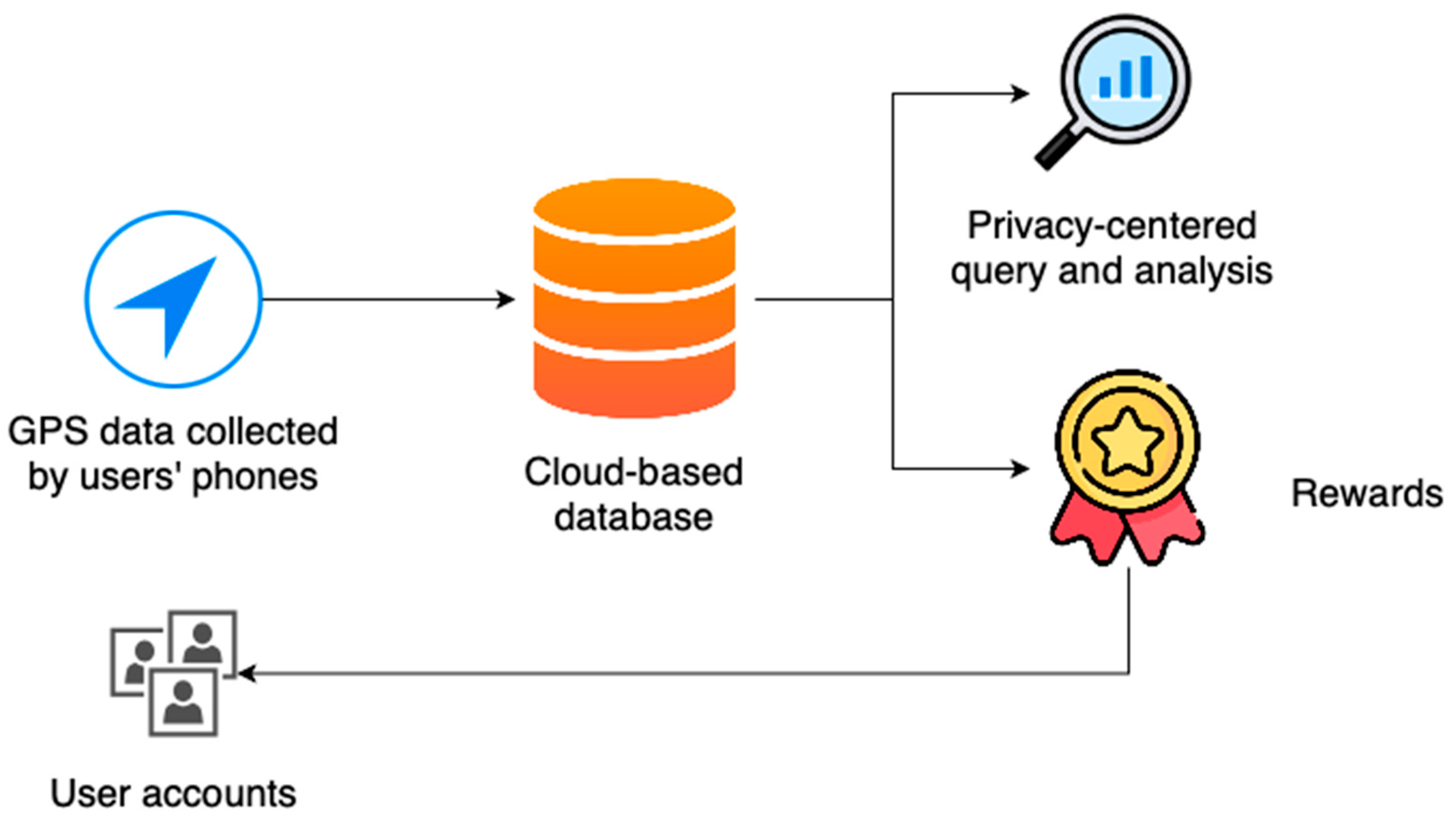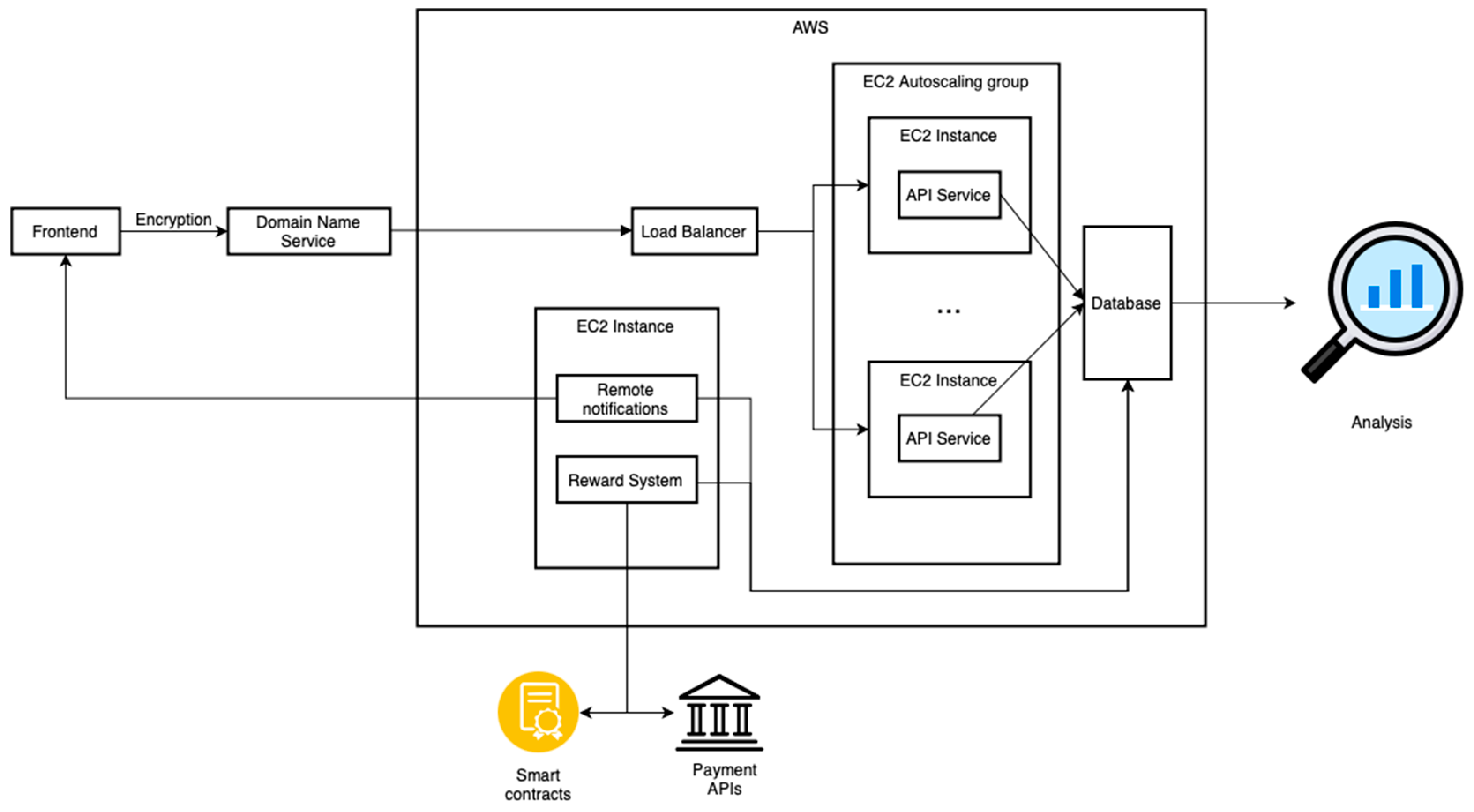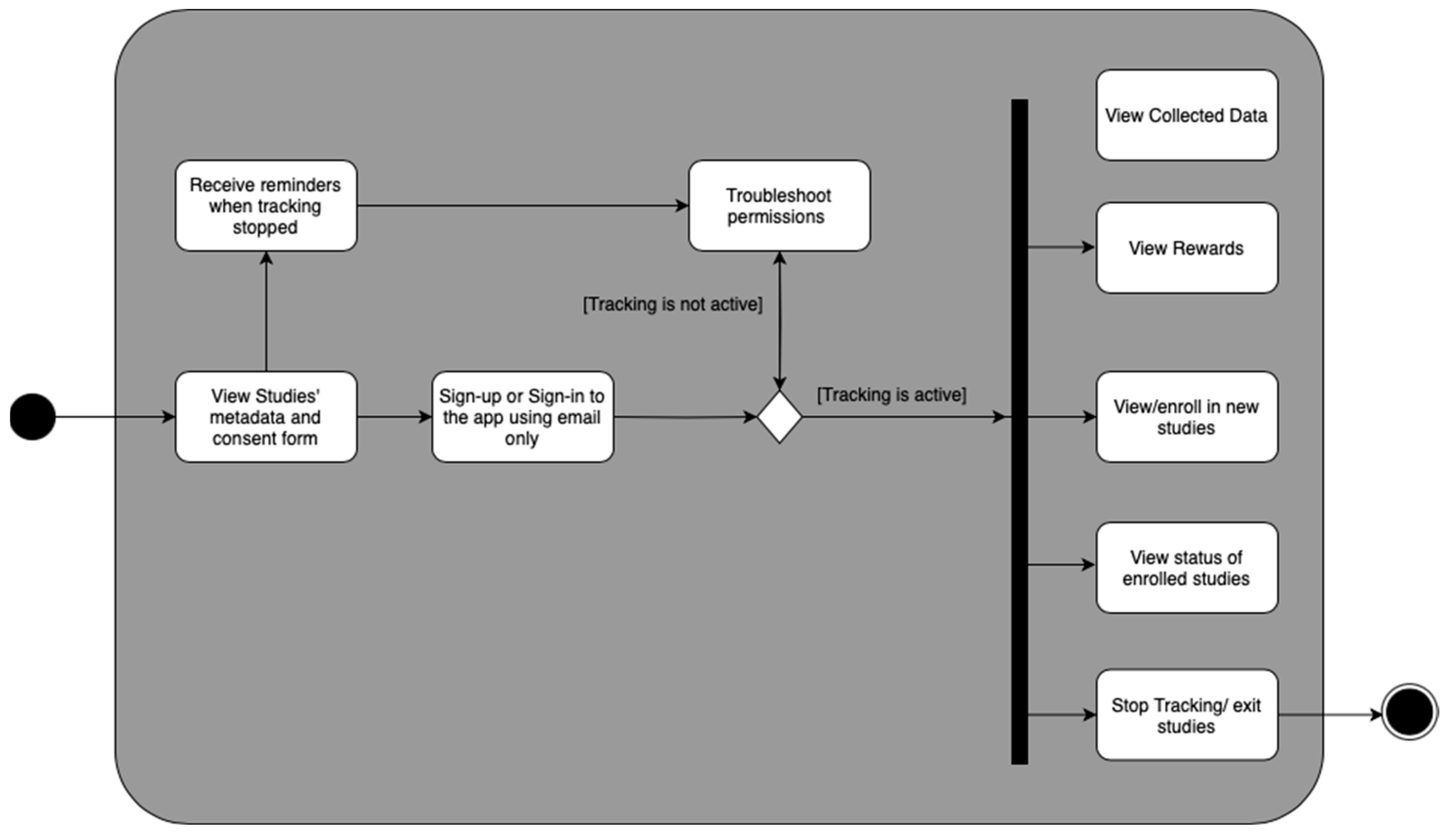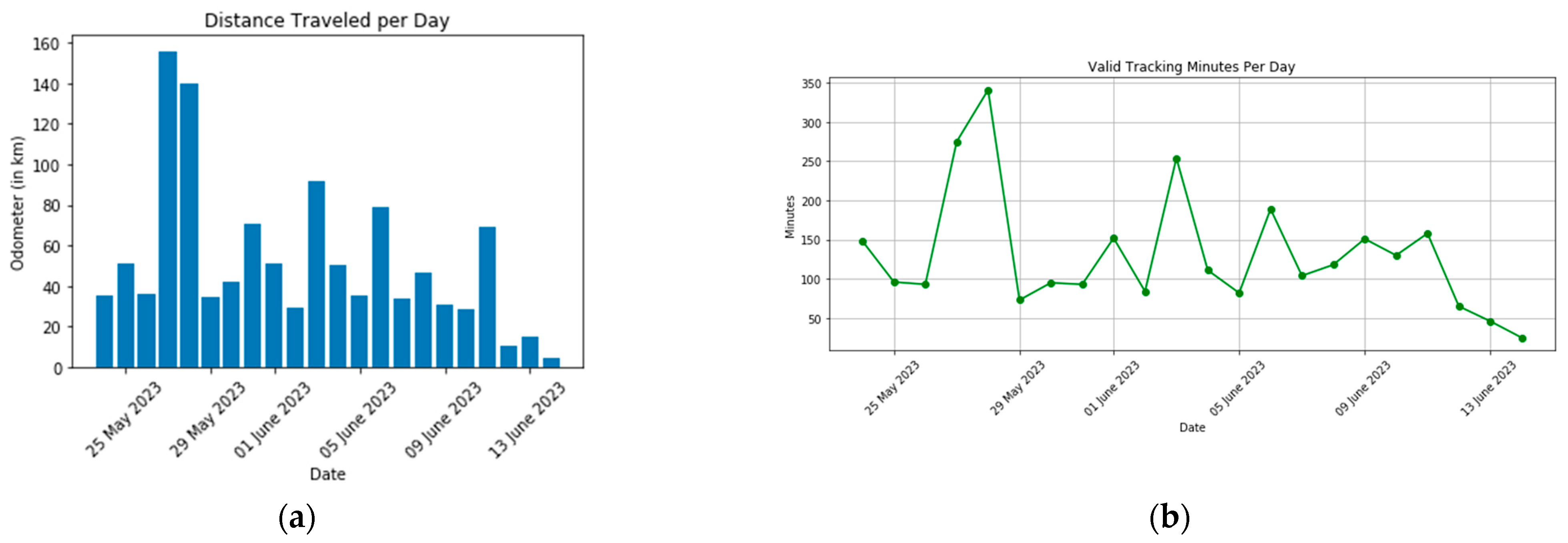A Mobile Health Application Using Geolocation for Behavioral Activity Tracking
Abstract
:1. Introduction
- Battery-efficient tracking logic that uses smartphone sensors to monitor physical activity and collect geolocation data.
- Scalable cloud architecture for sending and storing geolocation data while managing cost.
- Using Mobile Ads ID (MAID) to ensure data privacy, integrity, and usability in healthcare research.
2. Materials and Methods
2.1. Energy-Efficient Geotracking Logic
| Algorithm 1. Enhanced Motion-Assisted GPS Location Tracking |
| 1. Initialize the tracking system 2. Set t0 = current time 3. While (tracking is not terminated): 3.1. Query movement_status from the Operating System 3.2. If movement_status = STATIC: 3.2.1. Wait for Δt = 5 min 3.2.2. Deactivate GPS data requests 3.2.3. Monitor for changes in movement_status 3.3. Else if movement_status = IN_MOTITION: 3.3.1. Activate GPS data requests 3.3.2. Store GPS data in GPS_location_data 3.3.3. Monitor for changes in movement_status 3.4. Set t0 = current time |
2.2. Cloud Architecture
| Algorithm 2. Automated Remote Notification for User Engagement |
| 1. Query user IDs and the last notification time from the database and store it in user_information_list 2. For Each User u in user_information_list: 2.1. Query number of events that belong to u and store it in events 2.2. For event e in events 2.2.1. If e.event_type = PERMISSIONS_UPDATE 2.2.1.1. If e.values = true 2.2.1.1.1. Remove user u from notification table 2.2.1.2. If e.values = false 2.2.1.2.1. Set t0 = current time 2.2.1.2.2. Set t1 = last notification time for the user 2.2.1.2.3. If Δt ≥ user’s notification interval: 2.2.1.2.3.1. Set t = u.token 2.2.1.2.3.2. Send notification using Firebase 2.2.1.2.3.3. Update the database with the new notification information (i.e., date and time sent) |
| Algorithm 3. Automated Rewards for user compensation |
| 1. Query user IDs and balance from the database and store it in user_information_list 2. For Each User u in user_information_list: 2.1. Query number of events that belong to u and store it in events 2.2. For event e in events 2.2.1. If e.event_type = START_TRACKING 2.2.1.1. Set t0 = current time 2.2.1.2. Set t1 = e.timestamp 2.2.1.3. Set t2 = number of days required by the study 2.2.1.4. If t0 − t1 ≥ t2 2.2.1.4.1. Obtain the user-preferred payment method 2.2.1.4.2. Update user balance 2.2.1.4.1. If user preferred payment method is CYPTO 2.2.1.4.1 Execute smart contract 2.2.1.4.2. Else 2.2.1.4.1. Call PAYMENT_API |
2.3. Data Quality and Privacy
2.4. User Engagement and Usability
2.5. Rewards System
2.5.1. Blockchain
2.5.2. Payment APIs
3. Results
3.1. Accuracy of Geolocation Data
3.2. Activity Recognition
3.3. Battery Consumption
4. Discussion
4.1. App Novelty in the mHealth Field
4.2. Use Cases of Geolocation Data in Health
4.3. Ethical Considerations for Using Geolocation Data in Public Health Research
4.4. Limitations and Future Work
5. Conclusions
Author Contributions
Funding
Institutional Review Board Statement
Informed Consent Statement
Data Availability Statement
Acknowledgments
Conflicts of Interest
Appendix A

References
- Shaw, N.T. Geographical Information Systems and Health: Current State and Future Directions. Health Inform. Res. 2012, 182, 88–96. [Google Scholar] [CrossRef] [PubMed]
- Shahzad, M.; Upshur, R.; Donnelly, P.; Bharmal, A.; Wei, X.; Feng, P.; Brown, A.D. A population-based approach to integrated healthcare delivery: A scoping review of clinical care and public health collaboration. BMC Public Health 2019, 19, 708. [Google Scholar] [CrossRef] [PubMed]
- Aiello, A.E.; Renson, A.; Zivich, P.N. Social Media and Internet-Based Disease Surveillance for Public Health. Annu. Rev. Public Health 2020, 41, 101–118. [Google Scholar] [CrossRef] [PubMed]
- Polonsky, J.A.; Baidjoe, A.; Kamvar, Z.N.; Cori, A.; Durski, K.; Edmunds, W.J.; Eggo, R.M.; Funk, S.; Kaiser, L.; Keating, P.; et al. Outbreak analytics: A developing data science for informing the response to emerging pathogens. Philos. Trans. R. Soc. B Biol. Sci. 2019, 374, 20180276. [Google Scholar] [CrossRef]
- Quijano-Sánchez, L.; Cantador, I.; Cortés-Cediel, M.E.; Gil, O. Recommender systems for smart cities. Inf. Syst. 2020, 92, 101545. [Google Scholar] [CrossRef]
- Wongvibulsin, S.; Martin, S.S.; Saria, S.; Zeger, S.L.; Murphy, S.A. An Individualized, Data-Driven Digital Approach for Precision Behavior Change. Am. J. Lifestyle Med. 2019, 143, 289–293. [Google Scholar] [CrossRef]
- Garett, R.R.; Yang, J.; Zhang, Q.; Young, S.D. An online advertising intervention to increase adherence to stay-at-home-orders during the COVID-19 pandemic: An efficacy trial monitoring individual-level mobility data. Int. J. Appl. Earth Obs. Geoinform. 2022, 108, 102752. [Google Scholar] [CrossRef]
- Del Rosario, M.B.; Redmond, S.J.; Lovell, N.H. Tracking the Evolution of Smartphone Sensing for Monitoring Human Movement. Sensors 2015, 158, 18901–18933. [Google Scholar] [CrossRef]
- Majumder, S.; Deen, M.J. Smartphone Sensors for Health Monitoring and Diagnosis. Sensors 2019, 19, 2164. [Google Scholar] [CrossRef]
- Boulos, M.N.K.; Peng, G.; VoPham, T. An overview of GeoAI applications in health and healthcare. Int. J. Health Geogr. 2019, 18, 7. [Google Scholar] [CrossRef]
- Chang, T.; Hu, Y.; Taylor, D.; Quigley, B.M. The role of alcohol outlet visits derived from mobile phone location data in enhancing domestic violence prediction at the neighborhood level. Health Place 2022, 73, 102736. [Google Scholar] [CrossRef] [PubMed]
- James, P.; Jankowska, M.; Marx, C.; Hart, J.E.; Berrigan, D.; Kerr, J.; Hurvitz, P.M.; Hipp, J.A.; Laden, F. “Spatial Energetics”: Integrating Data From GPS, Accelerometry, and GIS to Address Obesity and Inactivity. Am. J. Prev. Med. 2016, 51, 792–800. [Google Scholar] [CrossRef] [PubMed]
- Bürgi, R.; Tomatis, L.; Murer, K.; de Bruin, E.D. Spatial physical activity patterns among primary school children living in neighbourhoods of varying socioeconomic status: A cross-sectional study using accelerometry and Global Positioning System. BMC Public Health 2016, 16, 282. [Google Scholar] [CrossRef] [PubMed]
- Marquet, O.; Hirsch, J.A.; Kerr, J.; Jankowska, M.M.; Mitchell, J.; Hart, J.E.; Laden, F.; Hipp, J.A.; James, P. GPS-based activity space exposure to greenness and walkability is associated with increased accelerometer-based physical activity. Environ. Int. 2022, 165, 107317. [Google Scholar] [CrossRef]
- Pramanik, P.K.D.; Sinhababu, N.; Mukherjee, B.; Padmanaban, S.; Maity, A.; Upadhyaya, B.K.; Holm-Nielsen, J.B.; Choudhury, P. Power Consumption Analysis, Measurement, Management, and Issues: A State-of-the-Art Review of Smartphone Battery and Energy Usage. IEEE Access 2019, 7, 182113–182172. [Google Scholar] [CrossRef]
- Onnela, J.-P.; Dixon, C.; Griffin, K.; Jaenicke, T.; Minowada, L.; Esterkin, S.; Siu, A.; Zagorsky, J.; Jones, E. Beiwe: A data collection platform for high-throughput digital phenotyping. J. Open Source Softw. 2021, 6, 3417. [Google Scholar] [CrossRef]
- Clouse, K.; Noholoza, S.; Madwayi, S.; Mrubata, M.; Camlin, C.S.; Myer, L.; Phillips, T.K. The Implementation of a GPS-Based Location-Tracking Smartphone App in South Africa to Improve Engagement in HIV Care: Randomized Controlled Trial. JMIR Mhealth Uhealth 2023, 11, e44945. [Google Scholar] [CrossRef]
- Bauer, C. On the (In-)Accuracy of GPS Measures of Smartphones: A Study of Running Tracking Applications. In Proceedings of the 11th Conference on Advances in Mobile Computing & Multimedia, Vienna, Austria, 2–4 December 2013; Association for Computing Machinery: New York, NY, USA, 2013; pp. 335–341. [Google Scholar]
- Merry, K.; Bettinger, P. Smartphone GPS accuracy study in an urban environment. PLoS ONE 2019, 14, e0219890. [Google Scholar] [CrossRef]
- Mathenjwa, T.; Nkosi, B.; Kim, H.; Bain, L.E.; Tanser, F.; Wassenaar, D. Ethical considerations in using a smartphone-based GPS app to understand linkages between mobility patterns and health outcomes: The example of HIV risk among mobile youth in rural South Africa. Dev. World Bioeth. 2022. [Google Scholar] [CrossRef]
- Parent, C.; Spaccapietra, S.; Renso, C.; Andrienko, G.; Andrienko, N.; Bogorny, V.; Damiani, M.L.; Gkoulalas-Divanis, A.; Macedo, J.; Pelekis, N.; et al. Semantic trajectories modeling and analysis. ACM Comput. Surv. 2013, 45, 1–32. [Google Scholar] [CrossRef]
- Jiang, J.-Y.; Chao, Z.; Bertozzi, A.L.; Wang, W.; Young, S.D.; Needell, D. Learning to Predict Human Stress Level with Incomplete Sensor Data from Wearable Devices. In Proceedings of the 28th ACM International Conference on Information and Knowledge Management, Beijing, China, 3–7 November 2019; Association for Computing Machinery: New York, NY, USA, 2019; pp. 2773–2781. [Google Scholar]
- Witze, A. GPS Is Doing More than You Thought. Knowable Magazine, Scientific American. 2019. Available online: https://www.scientificamerican.com/article/gps-is-doing-more-than-you-thought/ (accessed on 11 April 2023).
- Liao, L.; Lin, K.; Wang, X.; Lai, X. WiFi Positioning: A Survey. Int. J. Commun. Netw. Distrib. Syst. 2011, 7, 229–248. [Google Scholar]
- Feng, S.; Law, C.L. Assisted GPS and its impact on navigation in intelligent transportation systems. In Proceedings of the IEEE 5th International Conference on Intelligent Transportation Systems, Singapore, 3–6 September 2002. [Google Scholar]
- Carroll, A.; Heiser, G. An Analysis of Power Consumption in a Smartphone. In Proceedings of the 2010 USENIX Conference on USENIX Annual Technical Conference, Boston, MA, USA, 22–25 June 2010; Available online: https://dl.acm.org/doi/10.5555/1855840.1855861 (accessed on 18 May 2023).
- Mandrioli, C.; Leva, A.; Bernhardsson, B.; Maggio, M. Modeling of energy consumption in GPS receivers for power aware localization systems. In Proceedings of the 10th ACM/IEEE International Conference on Cyber-Physical Systems, Montreal, QC, Canada, 16–18 April 2019; pp. 217–226. [Google Scholar]
- Yan, Z.; Subbaraju, V.; Chakraborty, D.; Misra, A.; Aberer, K. Energy-Efficient Continuous Activity Recognition on Mobile Phones: An Activity-Adaptive Approach. In Proceedings of the International Symposium on Wearable Computers, Newcastle, UK, 18–22 June 2012; pp. 17–24. Available online: https://ieeexplore.ieee.org/document/6246136/ (accessed on 13 April 2023).
- Philosophy of Operation. GitHub. Available online: https://github.com/transistorsoft/react-native-background-geolocation/wiki/Philosophy-of-Operation (accessed on 11 April 2023).
- CMMotionActivityManager|Apple Developer Documentation. Available online: https://developer.apple.com/documentation/coremotion/cmmotionactivitymanager (accessed on 13 April 2023).
- ActivityRecognitionClient|Google Play Services. Google Developer. Available online: https://developers.google.com/android/reference/com/google/android/gms/location/ActivityRecognitionClient (accessed on 13 April 2023).
- BGAppRefreshTask. Apple Developer Documentation. Available online: https://developer.apple.com/documentation/backgroundtasks/bgapprefreshtask (accessed on 13 April 2023).
- Foreground Services. Android Developer. Available online: https://developer.android.com/guide/components/foreground-services (accessed on 13 April 2023).
- Hoffman, P.E.; McManus, P. DNS Queries over HTTPS (DoH); Internet Engineering Task Force: Fremont, CA, USA, 2018. [Google Scholar]
- Rescorla, E. The Transport Layer Security (TLS) Protocol Version 1.3; Internet Engineering Task Force: Fremont, CA, USA, 2018. [Google Scholar]
- Fundamentals of the Geodatabase—ArcGIS Pro|Documentation. Available online: https://pro.arcgis.com/en/pro-app/latest/help/data/geodatabases/overview/fundamentals-of-the-geodatabase.htm (accessed on 16 May 2023).
- Goodchild, M.F. Citizens as sensors: The world of volunteered geography. GeoJournal 2007, 69, 211–221. [Google Scholar] [CrossRef]
- General Data Protection Regulation (GDPR)—Official Legal Text. Gen Data Prot Regul GDPR. n.d. Available online: https://gdpr-info.eu/ (accessed on 16 May 2023).
- Cavoukian, A. Privacy by Design: The 7 Foundational Principles: Implementation and Mapping of Fair Information Practices; Information & Privacy Commissioner of Ontario: Toronto, ON, Canada, 2010. [Google Scholar]
- Pfoser, D.; Jensen, C.S.; Theodoridis, Y. Novel Approaches to the Indexing of Moving Object Trajectories. In Proceedings of the 26th International Conference on Very Large Data Bases, VLDB 2000, Cairo, Egypt, 10–14 September 2000; pp. 395–406. [Google Scholar]
- Ucipt-maid. Npm. 10 March 2022. Available online: https://www.npmjs.com/package/ucipt-maid (accessed on 14 April 2023).
- Vaghefi, I.; Tulu, B. The Continued Use of Mobile Health Apps: Insights from a Longitudinal Study. JMIR Mhealth Uhealth 2019, 7, e12983. [Google Scholar] [CrossRef] [PubMed]
- Leith, D.J.; Farrell, S. Coronavirus Contact Tracing App Privacy: What Data Is Shared by the Singapore Opentrace App? In Security and Privacy in Communication Networks; Sun, K., Foresti, S., Butler, K., Saxena, N., Eds.; Springer International Publishing: Cham, Switzerland, 2020; pp. 80–96. [Google Scholar]
- Wang, C.; Qi, H. Influencing Factors of Acceptance and Use Behavior of Mobile Health Application Users: Systematic Review. Healthcare 2021, 9, 357. [Google Scholar] [CrossRef] [PubMed]
- Dorri, A.; Kanhere, S.S.; Jurdak, R.; Gauravaram, P. Blockchain for IoT security and privacy: The case study of a smart home. In Proceedings of the 2017 IEEE International Conference on Pervasive Computing and Communications Workshops (PerCom Workshops), Kona, HI, USA, 13–17 March 2017; pp. 618–623. [Google Scholar]
- Kapassa, E.; Themistocleous, M.; Christodoulou, K.; Iosif, E. Blockchain Application in Internet of Vehicles: Challenges, Contributions and Current Limitations. Future Internet 2021, 13, 313. [Google Scholar] [CrossRef]
- Emish, M.; Chaparala, H.K.; Kelani, Z.; Young, S.D. On Monetizing Personal Wearable Devices Data: A Blockchain-based Marketplace for Data Crowdsourcing and Federated Machine Learning in Healthcare. Artif. Intell. Adv. 2022. [Google Scholar] [CrossRef]
- Ugarte, D.A.; Young, S. Attitudes About Cryptocurrency Incentives for Research Participation. Artif. Intell. Adv. 2023, 5, 1–7. [Google Scholar] [CrossRef]
- Garett, R.; Emish, M.; Young, S.D. Cryptocurrency as a new method for participant compensation in research. Health Policy Technol. 2023, 12, 100746. [Google Scholar] [CrossRef]
- Béres, F.; Seres, I.A.; Benczúr, A.A.; Quintyne-Collins, M. Blockchain is Watching You: Profiling and Deanonymizing Ethereum Users. In Proceedings of the 2021 IEEE International Conference on Decentralized Applications and Infrastructures (DAPPS), London, UK, 23–26 August 2021; pp. 69–78. [Google Scholar]
- Chaudhuri, S. Application of Web-Based Geographical Information System (GIS) in E-Business. In Digital Marketing and Consumer Engagement: Concepts, Methodologies, Tools, and Applications; IGI Global: Hershey, PA, USA, 2018; pp. 649–665. Available online: https://www.igi-global.com/chapter/application-of-web-based-geographical-information-system-gis-in-e-business/www.igi-global.com/chapter/application-of-web-based-geographical-information-system-gis-in-e-business/195116 (accessed on 19 April 2023).
- Schinasi, L.H.; Auchincloss, A.H.; Forrest, C.B.; Roux, A.V.D. Using electronic health record data for environmental and place based population health research: A systematic review. Ann. Epidemiol. 2018, 28, 493–502. [Google Scholar] [CrossRef]
- Kwan, M.-P. Algorithmic Geographies: Big Data, Algorithmic Uncertainty, and the Production of Geographic Knowledge. Ann. Am. Assoc. Geogr. 2016, 106, 274–282. [Google Scholar]
- Pappalardo, L.; Simini, F.; Barlacchi, G.; Pellungrini, R. scikit-mobility: An open-source Python library for human mobility analysis and simulation. arXiv 2019, arXiv:1907.07062. [Google Scholar]
- Cornacchia, G.; Pappalardo, L. A Mechanistic Data-Driven Approach to Synthesize Human Mobility Considering the Spatial, Temporal, and Social Dimensions Together. ISPRS Int. J. Geo-Inf. 2021, 10, 599. [Google Scholar] [CrossRef]
- Yi, L.; Wilson, J.P.; Mason, T.B.; Habre, R.; Wang, S.; Dunton, G.F. Methodologies for assessing contextual exposure to the built environment in physical activity studies: A systematic review. Health Place 2019, 60, 102226. [Google Scholar] [CrossRef] [PubMed]
- de Montjoye, Y.-A.; Hidalgo, C.A.; Verleysen, M.; Blondel, V.D. Unique in the Crowd: The privacy bounds of human mobility. Sci. Rep. 2013, 3, 1376. [Google Scholar] [CrossRef]
- Duncan, D.T.; Kapadia, F.; Regan, S.D.; Goedel, W.C.; Levy, M.D.; Barton, S.C.; Friedman, S.R.; Halkitis, P.N. Feasibility and Acceptability of Global Positioning System (GPS) Methods to Study the Spatial Contexts of Substance Use and Sexual Risk Behaviors among Young Men Who Have Sex with Men in New York City: A P18 Cohort Sub-Study. PLoS ONE 2016, 11, e0147520. [Google Scholar] [CrossRef]
- Schootman, M.; Nelson, E.J.; Werner, K.; Shacham, E.; Elliott, M.; Ratnapradipa, K.; Lian, M.; McVay, A. Emerging technologies to measure neighborhood conditions in public health: Implications for interventions and next steps. Int. J. Health Geogr. 2016, 15, 20. [Google Scholar] [CrossRef]
- Palmer, J.R.; Boggs, D.A.; Krishnan, S.; Hu, F.B.; Singer, M.; Rosenberg, L. Sugar-sweetened beverages and incidence of type 2 diabetes mellitus in African American women. Arch. Intern. Med. 2008, 168, 1487–1492. [Google Scholar] [CrossRef]
- Kestens, Y.; Chaix, B.; Gerber, P.; Desprès, M.; Gauvin, L.; Klein, O.; Klein, S.; Köppen, B.; Lord, S.; Naud, A.; et al. Understanding the role of contrasting urban contexts in healthy aging: An international cohort study using wearable sensor devices (the CURHA study protocol). BMC Geriatr. 2016, 16, 96. [Google Scholar] [CrossRef]
- Kestens, Y.; Wasfi, R.; Naud, A.; Chaix, B. “Contextualizing Context”: Reconciling Environmental Exposures, Social Networks, and Location Preferences in Health Research. Curr. Environ. Health Rep. 2017, 4, 51–60. [Google Scholar] [CrossRef]
- Yang, Y.; Roux, A.V.D.; Auchincloss, A.H.; Rodriguez, D.A.; Brown, D.G. A Spatial Agent-Based Model for the Simulation of Adults’ Daily Walking Within a City. Am. J. Prev. Med. 2011, 40, 353–361. [Google Scholar] [CrossRef]
- Oliver, M.; Badland, H.; Mavoa, S.; Witten, K.; Kearns, R.; Ellaway, A.; Hinckson, E.; Mackay, L.; Schluter, P.J. Environmental and socio-demographic associates of children’s active transport to school: A cross-sectional investigation from the URBAN Study. Int. J. Behav. Nutr. Phys. Act. 2014, 11, 70. [Google Scholar] [CrossRef] [PubMed]
- Carlson, J.A.; Schipperijn, J.; Kerr, J.; Saelens, B.E.; Natarajan, L.; Frank, L.D.; Glanz, K.; Conway, T.L.; Chapman, J.E.; Cain, K.L.; et al. Locations of Physical Activity as Assessed by GPS in Young Adolescents. Pediatrics 2016, 137, e20152430. [Google Scholar] [CrossRef] [PubMed]
- Taylor, L. No place to hide? The ethics and analytics of tracking mobility using mobile phone data. Environ. Plan. D Soc. Space 2016, 34, 319–336. [Google Scholar] [CrossRef]
- James, P.; Wilt, G.E.; Jimenez, M.P. Invited Perspective: Can My Smartphone Assess My Exposure? The Potential to Retroactively Estimate Personalized Exposures using Smartphone Location Data. Environ. Health Perspect. 2022, 130, 111304. [Google Scholar] [CrossRef] [PubMed]
- Garett, R.; Young, S.D. Geolocation, ethics, and HIV research. Health Technol. 2021, 11, 1305–1309. [Google Scholar] [CrossRef]
- Dubov, A.; Shoptawb, S. The Value and Ethics of Using Technology to Contain the COVID-19 Epidemic. Am. J. Bioeth. 2020, 20, W7–W11. [Google Scholar] [CrossRef]
- Carter, A.; Liddle, J.; Hall, W.; Chenery, H. Mobile Phones in Research and Treatment: Ethical Guidelines and Future Directions. JMIR mHealth uHealth 2015, 3, e95. [Google Scholar] [CrossRef]
- Garett, R.; Young, S.D. The importance of diverse key stakeholders in deciding the role of artificial intelligence for HIV research and policy. Health Policy Technol. 2022, 11, 100599. [Google Scholar] [CrossRef]








| Sensor | Accuracy | Energy |
|---|---|---|
| Cellular | 100 m | Low |
| WIFI | 10–50 m | Low |
| GPS | 5–10 m (outdoors) 10–20 m (indoors) | High |
| Table | Column | Description | Example |
|---|---|---|---|
| User Metadata | MAID | Mobile Advertising ID, unique identifier for each phone (primary key) | C3F0267B-CA56-4541-929D- E2BAC4979AC2 |
| Email address of the user | |||
| Phone Metadata | Operating system type and version number | ||
| IP Address | Internet Protocol Address | ||
| Firebase Token | Unique token for each device | ||
| Geolocation Rewards | UUID | Universally Unique ID for each location (primary key) | 964D5405-BD8D-4E9C-A221-442C5E92ED81 |
| MAID | Unique identifier for each phone (foreign key) | ||
| Study ID | Study Code (foreign key) | ||
| Timestamp | Time, data, and the time zone when location was recorded | ||
| Activity | The type of motion detected when location was recorded | still, on_foot, walking, running, in_vehicle, on_bicycle, unknown | |
| Battery | Percent of battery charge when the location was recorded | ||
| Coordinates | Latitude, longitude, altitude, and accuracy of the location | ||
| Odometer | Distance moved | ||
| Events | UUID | Universally Unique ID for each event (primary key) | |
| MAID | Unique identifier for each phone (foreign key) | ||
| Event Type | Code that corresponds to internal use | PERMISSIONS_UPDATE, TRACKING_STARTED | |
| Values | Metadata about the event, such as timestamp or Boolean values | ||
| Studies | Study ID | Study Code (primary key) | |
| Metadata | Description of the study, start/end dates, and other requirements | ||
| MAID | Unique identifier for each phone (foreign key) | ||
| Notifications | Timestamp | Time when row was last updated | |
| Notification Type | Code that corresponds to internal use | ||
| MAID | Unique identifier for each phone (foreign key) | ||
| Rewards | Balance | Value of rewards sent to the user |
| Indoor | Outdoor | |
|---|---|---|
| Number of data points | 1415 | 24,191 |
| Mean | 30.6 m | 8.29 m |
| Standard Deviation | 33.58 | 109.44 |
| 25th percentile | 3.1 m | 4.7 m |
| 50th percentile | 14.2 m | 4.7 m |
| 75th percentile | 35 m | 4.7 m |
Disclaimer/Publisher’s Note: The statements, opinions and data contained in all publications are solely those of the individual author(s) and contributor(s) and not of MDPI and/or the editor(s). MDPI and/or the editor(s) disclaim responsibility for any injury to people or property resulting from any ideas, methods, instructions or products referred to in the content. |
© 2023 by the authors. Licensee MDPI, Basel, Switzerland. This article is an open access article distributed under the terms and conditions of the Creative Commons Attribution (CC BY) license (https://creativecommons.org/licenses/by/4.0/).
Share and Cite
Emish, M.; Kelani, Z.; Hassani, M.; Young, S.D. A Mobile Health Application Using Geolocation for Behavioral Activity Tracking. Sensors 2023, 23, 7917. https://doi.org/10.3390/s23187917
Emish M, Kelani Z, Hassani M, Young SD. A Mobile Health Application Using Geolocation for Behavioral Activity Tracking. Sensors. 2023; 23(18):7917. https://doi.org/10.3390/s23187917
Chicago/Turabian StyleEmish, Mohamed, Zeyad Kelani, Maryam Hassani, and Sean D. Young. 2023. "A Mobile Health Application Using Geolocation for Behavioral Activity Tracking" Sensors 23, no. 18: 7917. https://doi.org/10.3390/s23187917
APA StyleEmish, M., Kelani, Z., Hassani, M., & Young, S. D. (2023). A Mobile Health Application Using Geolocation for Behavioral Activity Tracking. Sensors, 23(18), 7917. https://doi.org/10.3390/s23187917






